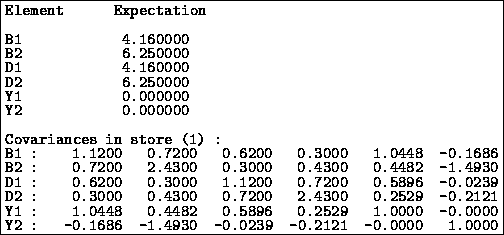We have retained our canonical directions as assignments; as linear combinations. The point is that by retaining them in this way (and not as elements), we don't have to take up room by defining the covariance matrices that would associate them with the other quantities which are, as elements, automatically associated with specific variance-covariance matrices. Hence the assignment is a very efficient way of retaining some quantities.
However, sooner or later we may want to construct elements from the assignments that exist, and we do so using the BUILD: command. This command can be used in different ways, for different purposes. To construct our canonical directions, which exist as assignments Y1 and Y2, we use it as follows:
BD>build:Y1 ![]()
BD>build:Y2 ![]()
Now we will use some of the commands that we used earlier in section
8 to examine our construction . Issue the following command to inspect the names of elements
and their associated covariance matrix:
. Issue the following command to inspect the names of elements
and their associated covariance matrix:
BD>look:(e,v1) ![]()

Figure 21: Constructing the canonical directions
giving the output shown in figure 21. There are several observations to be made about this sequence of commands and their resultant output: